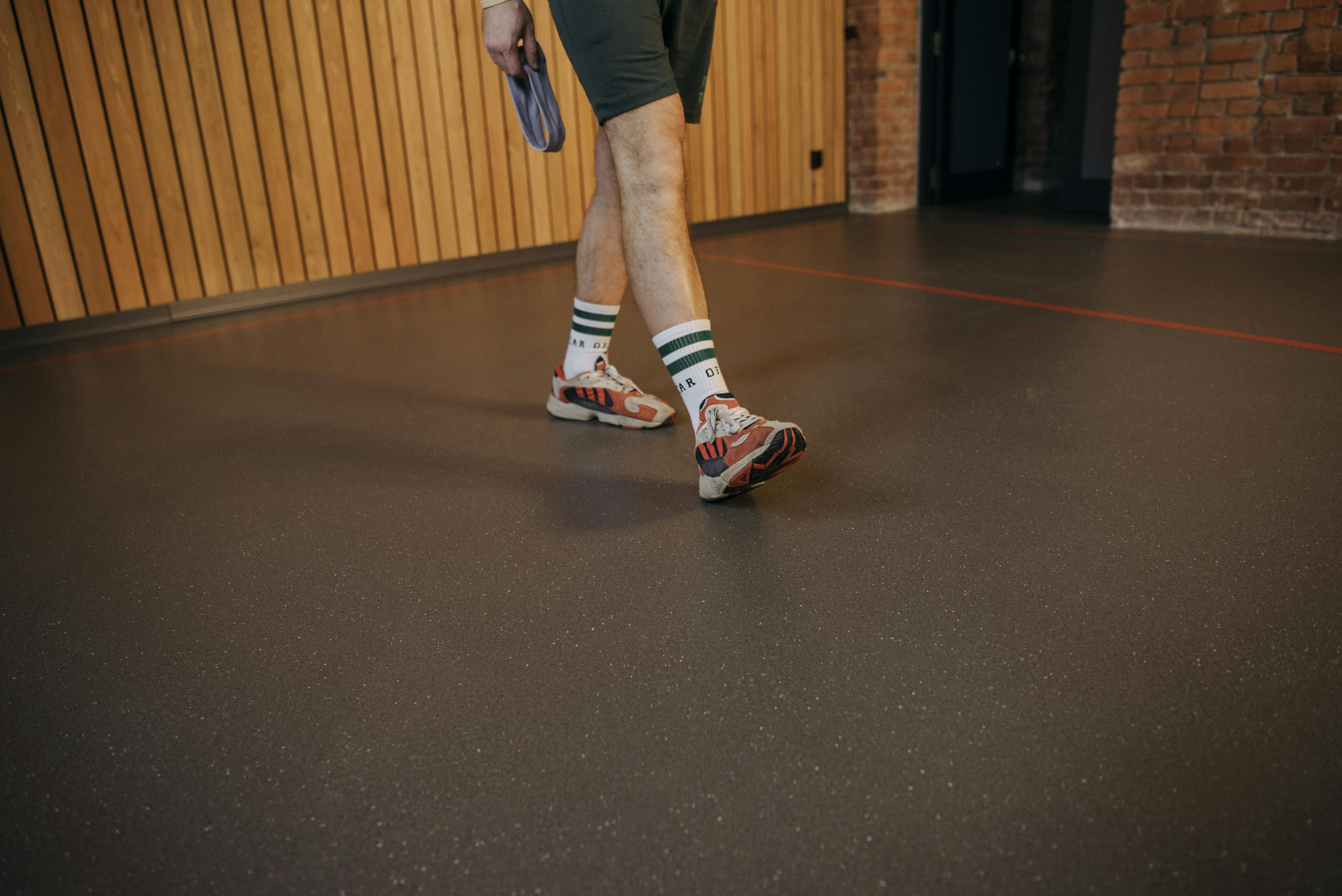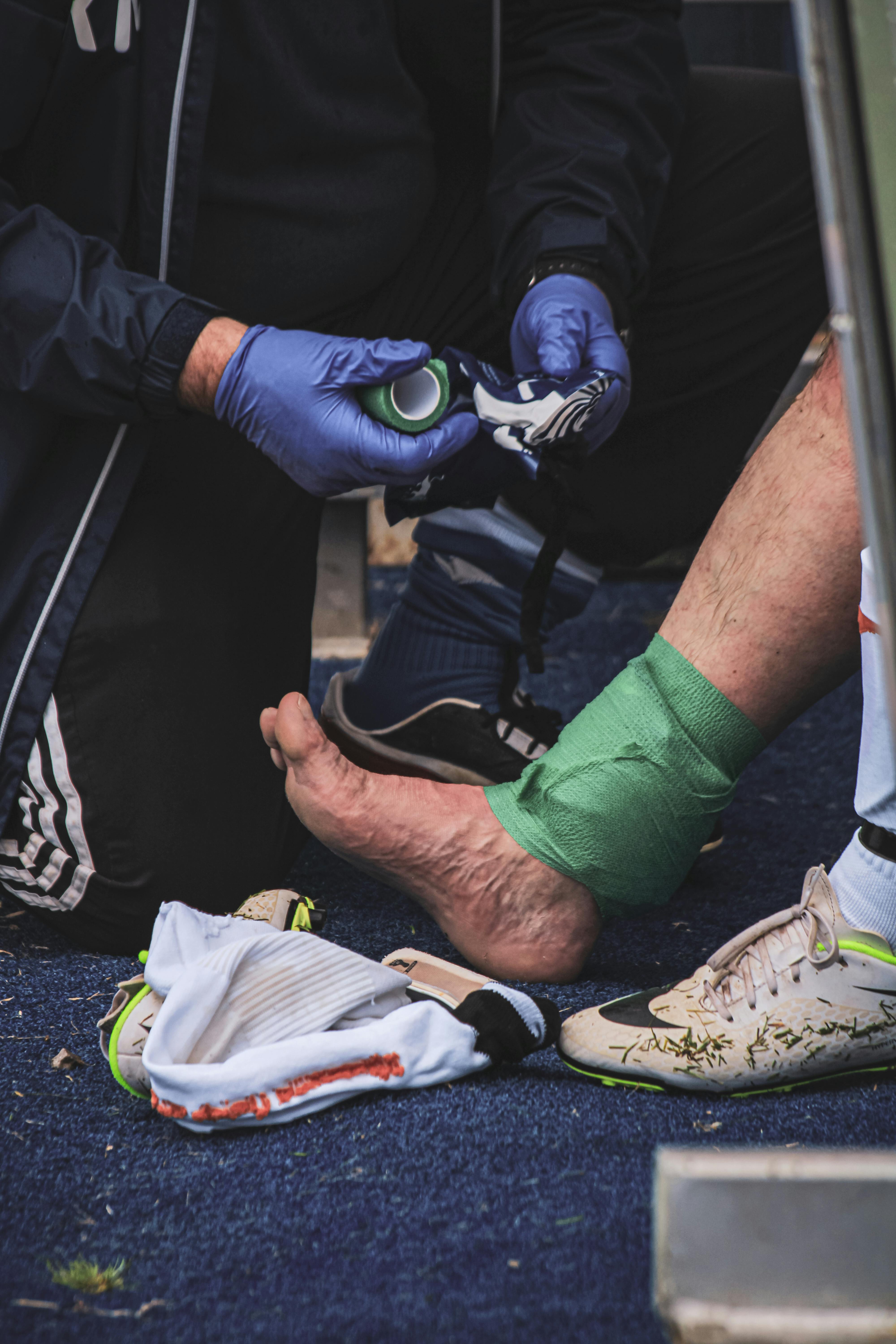What to Know About a High Ankle Sprain(Detailed Info)

Your ankles are like the silent heroes of your body, housing multiple ligaments that play a crucial role in keeping your feet stable and your joints functioning smoothly. However, when these ligaments get injured, it's like a disruption in the harmony of your movement, causing what we know as a sprain.
Among the various types of sprains, high ankle sprains stand out as somewhat rare, often stemming from specific sports or activities that put unique stress on the ankle.
Let's take a look into understanding the signs of a high ankle sprain and how to effectively address them in this article.
Table of Contents
- What Is a High Ankle Sprain?
- Types of High Ankle Sprains
- High Ankle Sprain Causes
- High Ankle Sprain vs Low Ankle Sprain
- High Ankle Sprain Symptoms
- High Ankle Sprain Diagnosis
- High Ankle Sprain Treatment
- When to consider ankle surgery
- High Ankle Sprain Recovery Time
- Signs of a Severe High Ankle Sprain
- Recovery Techniques for High Ankle Sprains
- Medical Remedies for High Ankle Sprains
- Recovery Time for High Ankle Sprains
- Rehabilitation Exercises for High Ankle Sprains
- Massage Therapy for High Ankle Sprains
- Sleeping Strategies for Comfort with a Sprained Ankle
- Bottom Line
What Is a High Ankle Sprain?
A high ankle sprain occurs when the ligaments connecting the shinbone (tibia) to the smaller bone next to it (fibula) are injured.
These ligaments, called syndesmosis, stabilize the ankle joint. Your ankle acts like a bridge between your leg and foot bones, with the talus bone fitting between the upper (tibia and fibula) and lower ankle bones.
Now, ligaments are like tiny ropes made of fibers, connecting one bone to another bone. They're the tough guys that keep everything stable and in place.
So, when you get a high ankle sprain, it's like a disruption in this well-oiled machine, causing discomfort and throwing off your balance. But with proper care and attention, you can get back to feeling steady on your feet in no time!
Types of High Ankle Sprains
High ankle sprains come in different types of severity, depending on how much damage the ligaments endure. There are three grades to consider:

Grade I sprains: These are mild and involve slight stretching or tearing of the ligaments. It's like a small hiccup in the stability of your ankle.
Grade II sprains: These are a bit more serious, involving partial tearing of the ligaments. It's like a moderate disruption in the strength of your ankle's support system.
Grade III sprains: These are the most severe, where the ligaments are completely torn. It's like a major roadblock in your ankle's ability to keep things steady.
High Ankle Sprain Causes
A high ankle sprain occurs when your ankle gets injured from a combination of upward flexion of your foot and a twisting motion, either inward or outward.
Unlike other ankle sprains caused by rolling, high ankle sprains usually result from some form of collision.
They commonly happen during activities like running or jumping, where sudden movements put extra strain on the ankle. Understanding how these sprains occur can help in preventing them and taking appropriate precautions during physical activities.
High Ankle Sprain vs Low Ankle Sprain
Looking at ankle injuries, about 80% of the cases involve what we call inversion sprains, where the ankle rolls inward and strains the tendons within the joint.
These often occur from a misstep and are quite common in sports.
On the other hand, high ankle sprains are a bit different. They happen when the ankle and leg twist outward, affecting the ligaments above the ankle in what's called an external rotation injury.
Both low and high ankle sprains typically lead to visible bruising and some swelling. However, high ankle sprains tend to take longer to heal, sometimes stretching from three weeks to four months or even longer in severe cases.
This prolonged healing period is because the ligaments above the ankle have a tougher job:
- The tibia and fibula bones naturally try to separate whenever a person stands, and it's the syndesmotic ligaments' job to keep them in place.
- Damage to these ligaments can destabilize not just the ankle but the entire leg, making it more challenging to regain stability.
- If not properly healed, it can lead to issues like scar tissue or chronically loose ligaments, increasing the risk of future sprains.
High Ankle Sprain Symptoms
Spotting a high ankle sprain amidst other ankle injuries involves paying attention to specific symptoms:
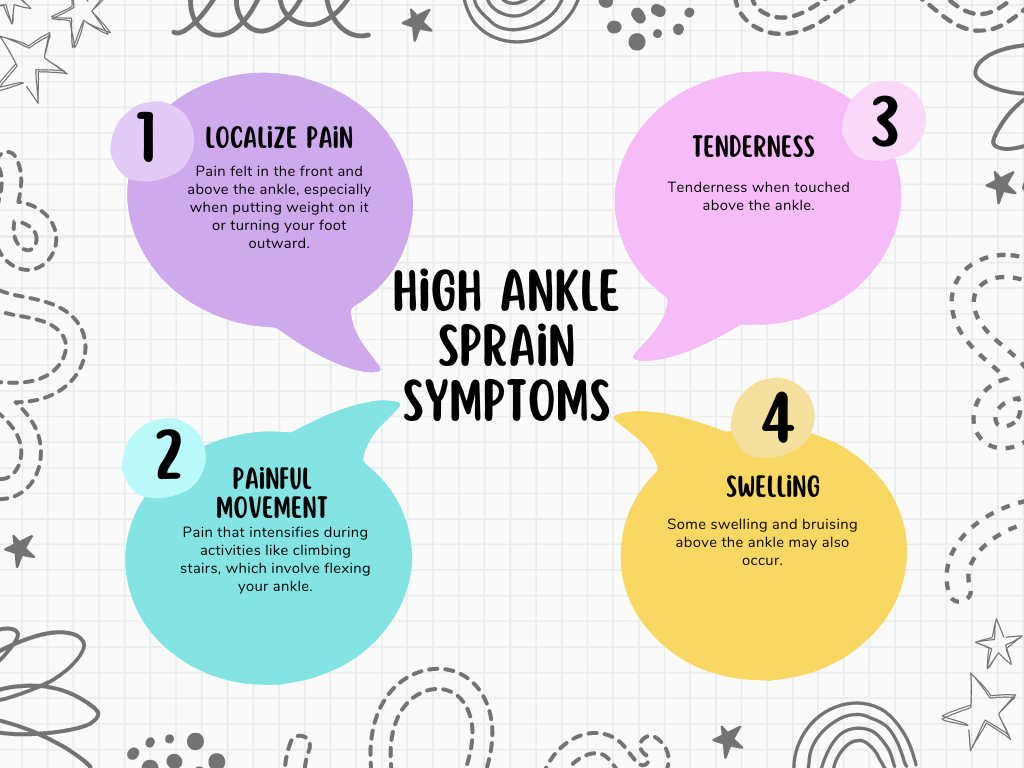
- Pain felt in the front and above the ankle, especially when putting weight on it or turning your foot outward.
- Pain that intensifies during activities like climbing stairs, which involve flexing your ankle.
- Tenderness when touched above the ankle.
- Some swelling and bruising above the ankle may also occur.
It's important to note that high ankle sprains might not swell as much as typical ankle sprains, which can make it tricky to recognize the seriousness of the injury.
This lack of swelling might lead people to underestimate the extent of their injury. Being aware of these symptoms can help ensure proper diagnosis and treatment for a speedy recovery.
High Ankle Sprain Diagnosis
When you visit your healthcare provider for a suspected high ankle sprain, they'll start by asking you questions about your injury and medical history. Following this, they'll conduct a thorough physical examination.
To diagnose a high ankle sprain, your provider might:
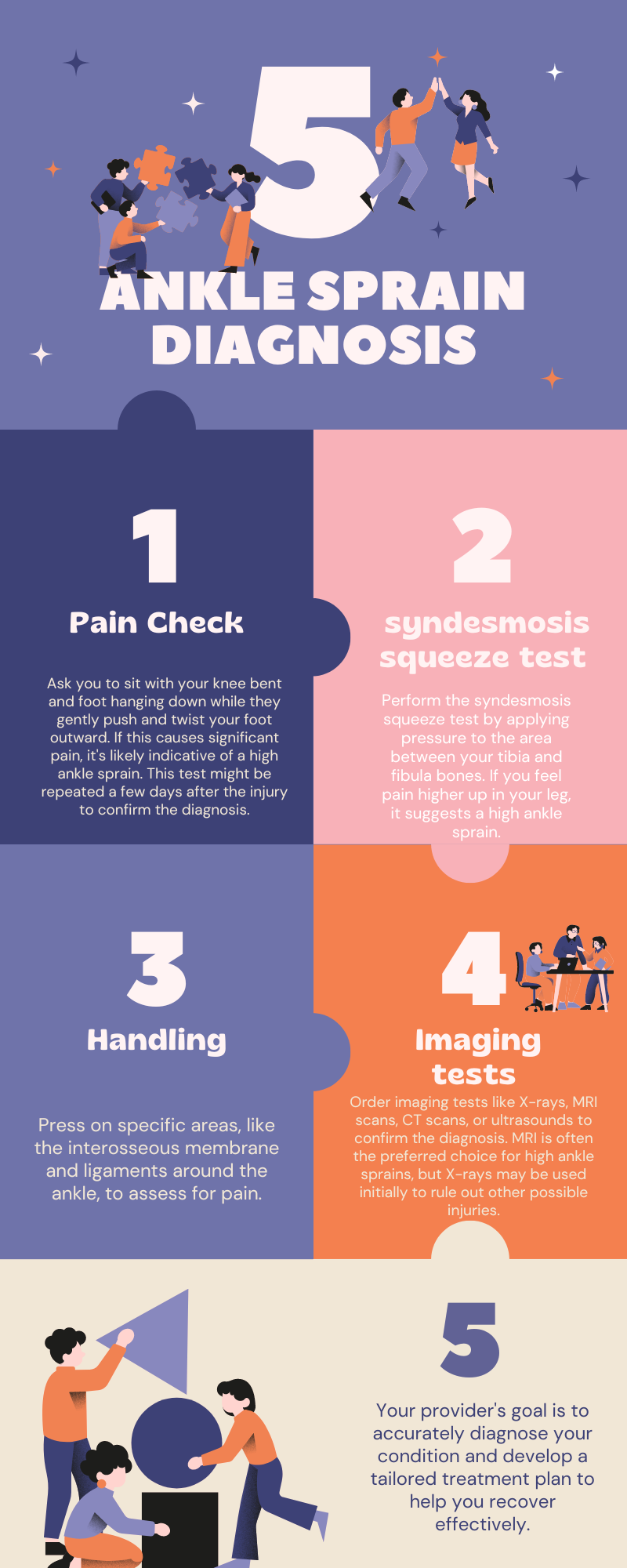
- Ask you to sit with your knee bent and foot hanging down while they gently push and twist your foot outward. If this causes significant pain, it's likely indicative of a high ankle sprain. This test might be repeated a few days after the injury to confirm the diagnosis.
- Perform the syndesmosis squeeze test by applying pressure to the area between your tibia and fibula bones. If you feel pain higher up in your leg, it suggests a high ankle sprain.
- Press on specific areas, like the interosseous membrane and ligaments around the ankle, to assess for pain.
- Order imaging tests like X-rays, MRI scans, CT scans, or ultrasounds to confirm the diagnosis. MRI is often the preferred choice for high ankle sprains, but X-rays may be used initially to rule out other possible injuries.
Your provider's goal is to accurately diagnose your condition and develop a tailored treatment plan to help you recover effectively.
High Ankle Sprain Treatment
When dealing with Grade 1 or 2 high ankle sprains, we typically kick off treatment with the RICE method:
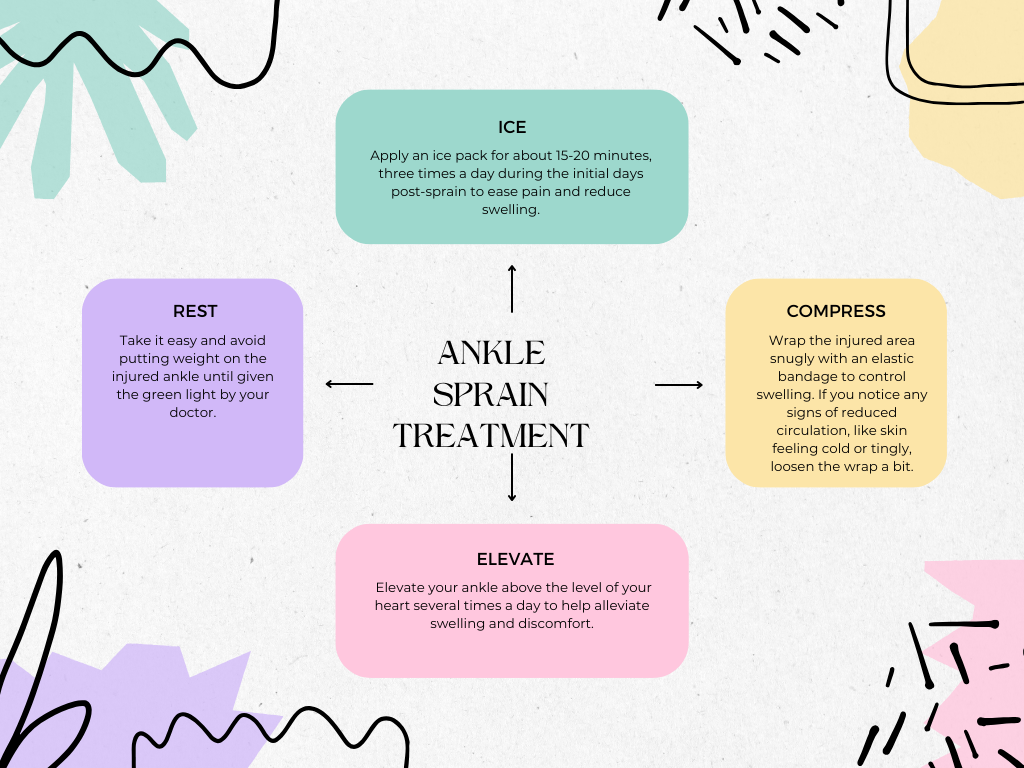
- Rest: Take it easy and avoid putting weight on the injured ankle until given the green light by your doctor.
- Ice: Apply an ice pack for about 15-20 minutes, three times a day during the initial days post-sprain to ease pain and reduce swelling.
- Compress: Wrap the injured area snugly with an elastic bandage to control swelling. If you notice any signs of reduced circulation, like skin feeling cold or tingly, loosen the wrap a bit.
- Elevate: Elevate your ankle above the level of your heart several times a day to help alleviate swelling and discomfort.
High ankle sprains aren't just limited to football; they're also common in sports like soccer, basketball, ice skating, and trampolining.
To manage pain, over-the-counter pain relievers such as ibuprofen or acetaminophen can be quite effective. Additionally, we might suggest using crutches or wearing an immobilizing boot to prevent further injury while you're on the road to recovery.
To support your healing, your provider may suggest using a brace, tape, or even a cast to restrict movement and prevent excessive bending of your ankle towards your body.
Additionally, they might recommend physical therapy, which could involve using therapeutic bands or exercises in water. Exercising in water can be beneficial as it reduces the amount of weight your ankle needs to bear, making movements gentler and more manageable.
In most cases, surgery isn't necessary for treating a high ankle sprain unless the damage is severe or if your ankle remains unstable despite other treatments. Your provider's goal is to find the most effective and least invasive ways to help you recover and regain stability in your ankle.
When to consider ankle surgery
For more severe Grade 2 and Grade 3 high ankle sprains, your doctor might recommend surgery to repair the damaged ligaments and stabilize the ankle.
Surgery aims to restore the ligaments to their normal length, providing stability and reducing the risk of further injury.
During the procedure, a small camera is used to visualize the inside of the ankle joint. The orthopedic surgeon then removes any loose bone or cartilage fragments and repairs the torn ligament using stitches or a tissue graft.
In some cases, a braided polyethylene cord may be used instead of surgical screws to stabilize the leg and align the bones for faster healing.
After surgery, you'll undergo immobilization with a cast or boot and start physical therapy to rebuild strength and regain range of motion.
The time it takes to fully recover varies, ranging from six weeks to four months or longer for more complex repairs. Your doctor will guide you through the recovery process, ensuring you receive the support and care needed for a successful recovery.
High Ankle Sprain Recovery Time
Recovery from high ankle sprains typically takes a bit longer compared to low ankle sprains, often around 6 to 8 weeks. However, your doctor may advise you to refrain from engaging in strenuous activities for an extended period to ensure proper healing.
Additionally, they might recommend undergoing physical therapy sessions to help rebuild strength and regain full mobility in your injured ankle.
Remember, your doctor's guidance and support during this recovery period are crucial for ensuring a successful and lasting recovery.
Signs of a Severe High Ankle Sprain
When you have an ankle sprain, the affected ligament might feel tender to the touch. If no bones are broken, your doctor can often determine the severity of the sprain by assessing factors like swelling, pain, and bruising.
During the physical examination, there may be discomfort as the doctor gently moves your ankle in different directions to identify which ligament is injured or torn. Your doctor's aim is to provide a thorough assessment to guide the most effective treatment for your recovery, ensuring you receive the care and support you need to heal properly.
Recovery Techniques for High Ankle Sprains
When you've experienced an ankle sprain, acting swiftly can make a big difference in your recovery. Here are steps you can take to speed up and ensure a complete recovery:
- Protecting
Your first priority is safeguarding the injured ankle from further harm. Avoid activities that could worsen the injury and refrain from putting any weight on the affected leg. Resting in a lying or seated position can help minimize strain on the ankle.
- Resting
Allowing your body time to heal is crucial. Limit your movement, especially walking, to give your body's natural healing process a chance to kick in. Minimize putting weight on the injured foot whenever possible.
- Icing
Ankle sprains often lead to swelling and pain. To alleviate these symptoms, apply ice to the affected area.
Remember not to apply ice directly to the skin; instead, wrap a bag of ice or frozen items in a towel and place it on the ankle.
Alternatively, you can use a bag of frozen vegetables like corn or peas wrapped in a cloth.
- Compressing:
Compression helps prevent excessive swelling by limiting fluid accumulation in the ankle joint.
Wrap the foot with an elastic bandage or tensor, ensuring to cover from the toes to the mid-calf region.
Be cautious not to wrap too tightly; the foot should still feel comfortable and able to move. If it feels excessively tight or affects circulation, loosen the bandage.
- Elevating
Elevating the injured leg during recovery is essential. It not only aids in resting and relieving pressure from the foot but also enhances circulation in the leg.
Elevating the leg reduces the buildup of blood and fluids, promoting comfort and facilitating healing.
By following these steps promptly and consistently, you can support your ankle's recovery process and ensure a smoother path to getting back on your feet.
Medical Remedies for High Ankle Sprains
Doctors often prescribe analgesics and non-steroidal anti-inflammatory drugs (NSAIDs) to manage pain and inflammation associated with ankle sprains. However, the decision on which medication to use ultimately rests with the clinician. The primary goal of treatment for ankle sprains is pain control.
There's some debate surrounding the use of NSAIDs. Some doctors believe that NSAIDs help reduce swelling, thus speeding up recovery.
On the other hand, others argue that NSAIDs, by inhibiting platelets, may actually increase the risk of additional swelling by promoting bleeding.
In cases where NSAIDs aren't used, acetaminophen or other pain relievers may be necessary to manage pain, especially in patients with moderate to severe ankle sprains.
Your doctor will carefully consider your individual circumstances and medical history to determine the most appropriate medication and treatment plan for your ankle sprain. Your comfort and well-being are their top priorities throughout the healing process.
Recovery Time for High Ankle Sprains
The recovery time for a sprained ankle can vary depending on how severe the injury is. Mild sprains might only take a few days to a couple of weeks to heal, but if the sprain is more moderate to severe, it could take several weeks to several months for full recovery.
Recovery from an ankle sprain typically involves rest, along with physical therapy and exercises to strengthen the muscles and ligaments in the ankle.
It's crucial to stick to the treatment plan recommended by a healthcare professional to ensure proper healing and to reduce the risk of re-injury.
Related: Ankle sprain first aid
Keep in mind that complete recovery might take anywhere from 6 to 12 months. Some individuals may still experience pain or instability in the ankle even after the initial healing period. In such cases, ongoing treatment like physical therapy may be advised to manage symptoms and improve the overall function of the ankle.
Your health and well-being are paramount, so don't hesitate to seek guidance and support from your healthcare provider throughout the recovery process.
Rehabilitation Exercises for High Ankle Sprains
To prevent re-injury, it's essential to incorporate daily stretching into your routine, especially before and after physical activities.
Even after your ankle feels better, it's crucial to continue with rehabilitation exercises several times a week to maintain its strength.
The specific timing and types of rehab exercises may vary based on your doctor's or physical therapist's recommendations. Typically, you'll engage in the following types of exercises:
- Range-of-motion exercises: These exercises help you move your ankle joint as much as possible in all directions.
2. Stretching exercises: These are designed to keep your Achilles tendon (heel cord) flexible as your ankle heals.
- Strengthening exercises: These exercises focus on building strength in the muscles surrounding your ankle to provide better support.
- Balance and control exercises: These exercises are aimed at improving your foot and ankle's ability to respond effectively to various activities, ultimately reducing the risk of re-injury.
By incorporating these exercises into your routine, you'll not only aid in your ankle's recovery but also help prevent future injuries.
Remember, consistency is key, and listening to your body's cues is important to ensure a safe and effective rehabilitation process.
Your dedication to your recovery will pay off in the long run, allowing you to regain strength and stability in your ankle.
Massage Therapy for High Ankle Sprains
Massage therapy for high ankle sprains can play a crucial role in the healing process by promoting circulation, reducing muscle tension, and aiding in the recovery of damaged ligaments.
Massage techniques such as cross-friction massage, which involves applying direct pressure across the ligament rather than along it, can help break down scar tissue and improve flexibility in the affected area.
When performing cross-friction massage for a sprained ankle, apply direct pressure using a single finger, moving it backward and forward across the ligament rather than along it.
It's normal for this massage technique to feel somewhat uncomfortable, but it's crucial to stay within your pain tolerance limits.
If the massage causes you to tighten up with pain or flinch, it's a sign that the treatment may not be beneficial.
Your comfort and well-being are paramount, so it's essential to communicate any discomfort to ensure the massage is effective and safe for your recovery.
During a massage session, the therapist may gently manipulate the ankle and surrounding tissues to alleviate pain and discomfort. However, it's essential to communicate any discomfort or pain levels during the massage to ensure the treatment remains within your pain tolerance limits.
Sleeping Strategies for Comfort with a Sprained Ankle
When dealing with a sprained ankle, adjusting your sleeping position can make a big difference in your comfort and recovery.
Adding a couple of extra pillows to your bed can be incredibly helpful. These pillows serve two main purposes: first, they elevate your foot, which promotes better blood flow and reduces swelling.
Second, they help separate your feet, aiding in fluid drainage and further reducing swelling.
The key goal is to elevate your injured foot above the level of your heart if possible. This position encourages efficient circulation and helps alleviate discomfort while you rest.
By taking these simple steps, you can support your body's healing process and enhance your overall comfort during sleep.
Bottom Line
By understanding the nature of high ankle sprains and following appropriate treatment and rehabilitation protocols, individuals can effectively manage their injuries and facilitate a smoother recovery process.
Also read; Sprained vs. Broken Ankle: What Are the Differences?


